Autumn feeding of currants: how and how to fertilize the bushes after harvest
One of the most important components of currant care is its feeding in the autumn, which gives a real effect in laying the future harvest, improving its quality, and increasing weight. Taking into account the needs of the berry culture, it is necessary to correctly determine the options, methods for feeding currants after the end of fruiting and harvesting, as well as other necessary autumn activities: pruning and pest control.
You will find detailed information about all this below.
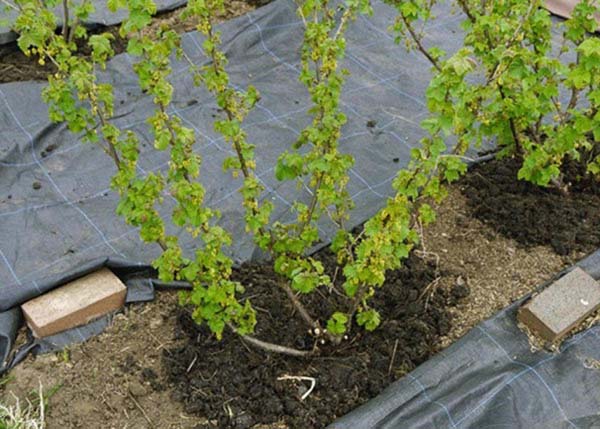
Content
In what cases is it required and why is it necessary to feed currants in the fall
Autumn feeding of currants is carried out in order to prepare it for winter (so that it regains strength and can endure frosts well), namely, so that the shrub will lay flower buds well for the next year, which means that it will give a bountiful harvest in the future.
Fertilizing currants in the fall (after harvesting) must be done in the following cases:
- If the fruiting of the berry bush was intense enough (that is, he spent all his strength and they must be restored);
- If the bush has been growing for a long time, that is, more than 3-4 years have passed since planting, which means that the fertilizers that were applied during its planting have long been "sucked", and the land is depleted.
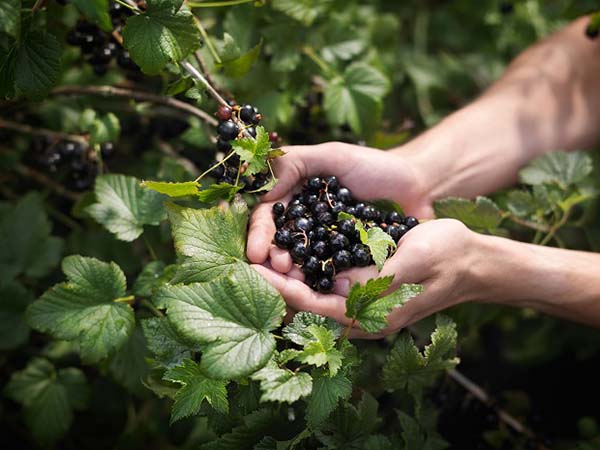
Worth knowing! The end of fruiting and harvesting of currants, as a rule, falls on the end of summer (sometimes even in the middle), but such top dressing is usually called autumn, because fertilizers are still applied after a while, that is, closer to autumn - in August-September ( in the middle lane and the Moscow region).
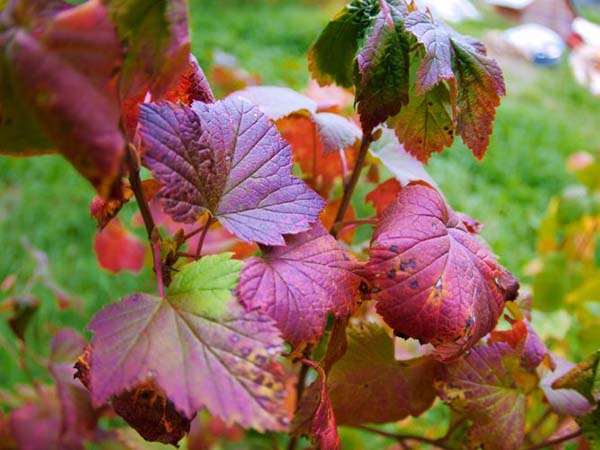
How to feed currants in the fall
In the period after fruiting, currants require phosphorus-potassium supplementation (a little more phosphorus, a little less potassium), since it is these fertilizers that are responsible for the growth and strengthening of the root system of the shrub, its resistance in winter (frost resistance) and immunity to various kinds of diseases.
Note! It is always necessary to feed on damp ground, that is, first it is necessary to water the plant so that the shrub does not burn the roots from the applied fertilizer. Water consumption is about 10-20 liters per bush, depending on its size and age.
Consider several different options and methods (combinations of funds - mineral and organic), how you can feed currants in the fall after fruiting.
1 way
One of the options for preparing liquid phosphorus-potassium supplements for currants in the fall:
- Ammophos (52% phosphorus, 12% nitrogen). You need to take 2 tbsp for a bucket of water. spoons (30-40 grams) of the product. But first any granular mineral fertilizer is better to dissolve in a separate container in hot water (but not boiling water), since granules, as a rule, dissolve rather poorly and reluctantly.
- Pour out there wood ash... Again, for a bucket of water, you need 1-2 glasses of ash (100-200 grams).
- Mix and mix everything well.
- Under the bush, depending on its age, you need to pour 1-2 liters of nutrient solution, if completely overgrown, then up to 5 liters.
- Loose and add mulch so that no crust forms on the surface.
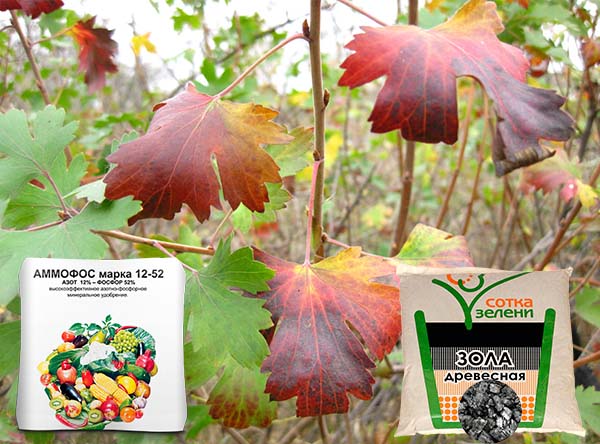
By the way! In the ash that was obtained from deciduous trees (by burning them), contains more potassium, and from conifers - phosphorus.
2 way
Another option for liquid autumn feeding of currants using mineral fertilizers:
- 1/2 tbsp. spoons urea or nitrate (7-10 grams each), or 0.5 liter green fertilizer dissolve in a bucket of water.
- Then add 1 tbsp there. spoon potassium sulfate or potassium sulfate (15-20 grams).
- And finally, 2 tbsp. spoons superphosphate (30-40 grams).
- Pour 1-2 liters of top dressing under young bushes. If the bush is adult, then you can up to 5 liters.
- Loosen and mulch so that a crust does not form on the ground.
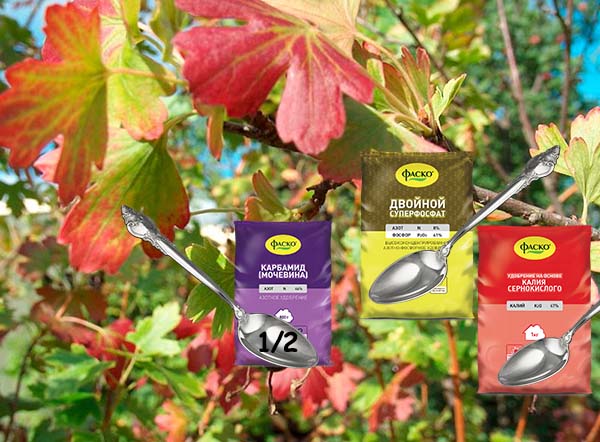
Advice! If you want the fertilizer to get as close to the roots as possible, then you can dig several holes 20-30 cm deep around the crown perimeter (somewhere at a distance of 30-40 centimeters from the center) (or make grooves). Pour top dressing there, and then dig in.
3 way
If you are a supporter of organic farming (but not ardent, because it is almost impossible to do without mineral fertilizers), then you can first mulch the trunk circle currants humus or high-quality compost (about 1 bucket - for an adult bush, 0.5 buckets - for a young one), and then it is still recommended to spill the bush with a solution superphosphate (30-40 grams per bucket of water).
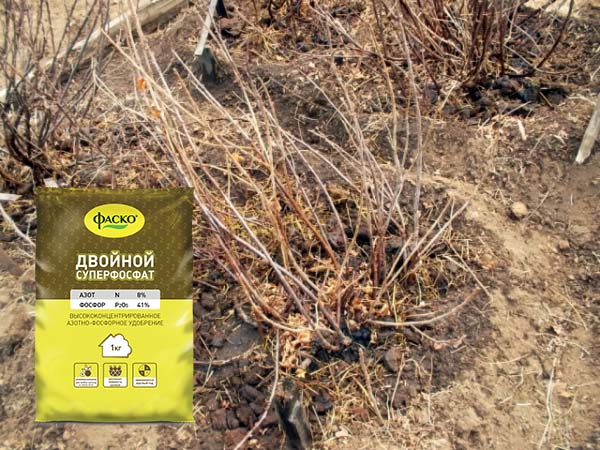
Note! The illustrations show picture of double superphosphate, accordingly, it needs to be made 2 times less than usual.
Method 4 (chicken droppings)
A good idea for lovers of organic fertilizers would be to feed a currant bush chicken droppings... Moreover, it can be made both for digging, that is, in dry form (consumption 0.8-1 kg per one bush), or prepare a solution (1 to 15).
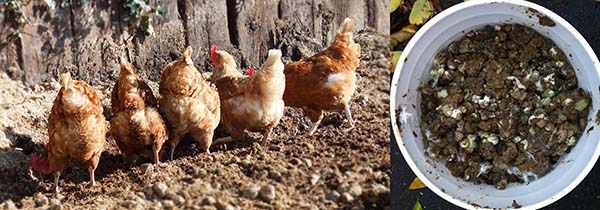
Important! If you are applying dry fertilizer to the trunk circle, then the digging depth should be about 1/2 of the shovel bayonet or 12-15 centimeters. Moreover, you just need to mix the dry top dressing well with the ground so that the plant does not get burned due to the direct contact of its root system with this fertilizer.
Of course, chicken droppings alone will not be enough, so a little later it is advisable to add to the trunk circle (for digging), again in a dry form, for example, 1 tbsp. spoon (15-20 grams) potassium sulfate (or potassium salt) and 2 tbsp. spoons superphosphate (30-40 grams) per 1 bush. Alternatively, you can prepare a liquid top dressing by dissolving the named fertilizers in the same proportions in 10 liters of water.
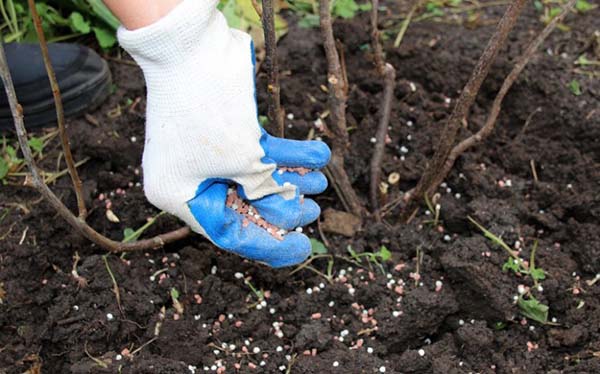
Video: caring for currants after harvesting - feeding and protection against kidney mites
Method 5 (special fertilizers)
For more lazy and economical summer residents, there are special complex autumn fertilizers (which contain both phosphorus and potassium, as well as a little bit of nitrogen), some of which are not very expensive, so they were able to gain popularity.
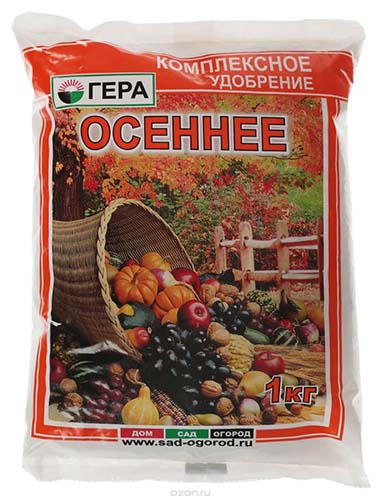
By the way! In addition to root dressings, there are foliar dressings (spraying on a leaf). It is only better to do them at the same time, because with foliar, the leaf absorbs and assimilates fertilizers many times faster, but the effect of such feeding is much shorter. In general, foliar feeding is rather an emergency measure when you need to either quickly heal or support the plant. And root is a solid or "long-playing" top dressing, more suitable for the autumn period (preparation for winter).
Other autumn activities for the care of currants
In addition to feeding, you will also need to carry out the following important autumn activities to prepare currants for winter and the next season:
- Autumn pruning (sanitary - after fruiting, shaping and rejuvenating - after all the leaves have fallen off). Sanitary pruning involves removing all damaged and infested branches (including those lying on the ground) and leaves.
Advice! All information about pruning currants in the fall — in this material.
- Mulching and sheltering for the winter.
Note! More complete information about autumn care and preparation of currants for winter you'll find in this article.
- Autumn treatment against pests and diseases.
The site has a separate article about eradicating autumn processing of fruit trees and berry bushes.
- You can also transplant a bush in the fall.
Important! All detailed information about transplanting currants to a new place you can get from this material.
By properly fertilizing currants in the fall, we lay the foundation for the future harvest, as we provide everything necessary for growth and active strengthening of the roots, increasing immunity and frost resistance. The main thing is to comply with the terms and dosage of feeding.
Video: fertilizing currants after harvesting (in autumn)


Thank you very much! I am a beginner summer resident, I was looking on the Internet for material on feeding currants in the fall, your article is the most understandable and specific!